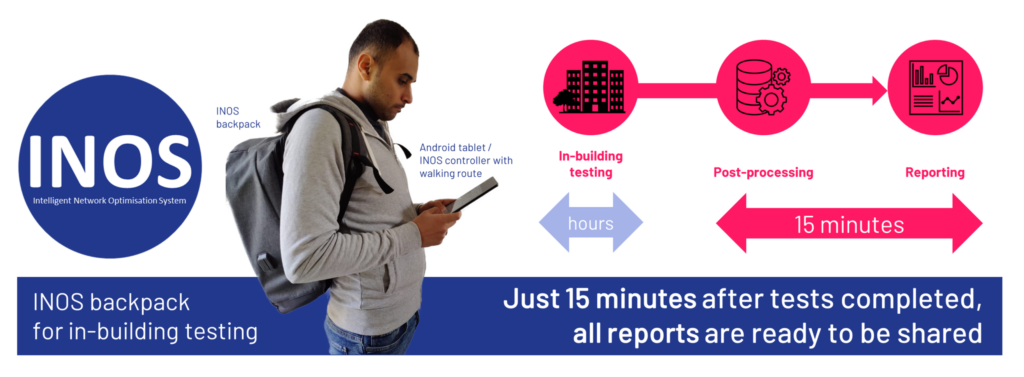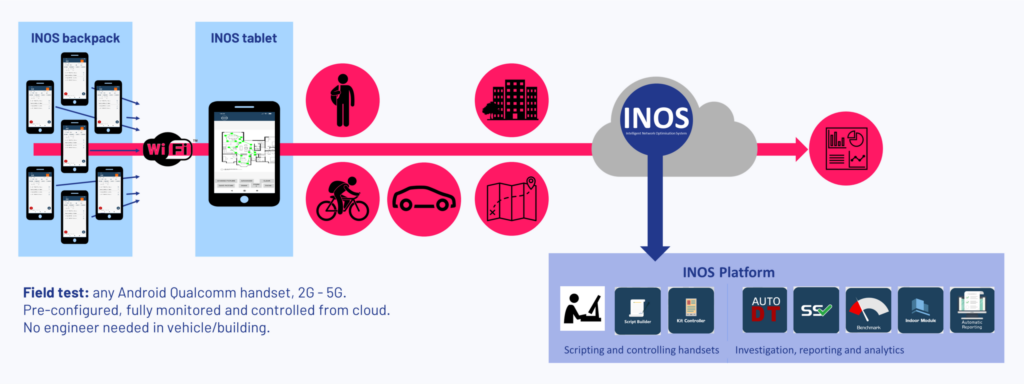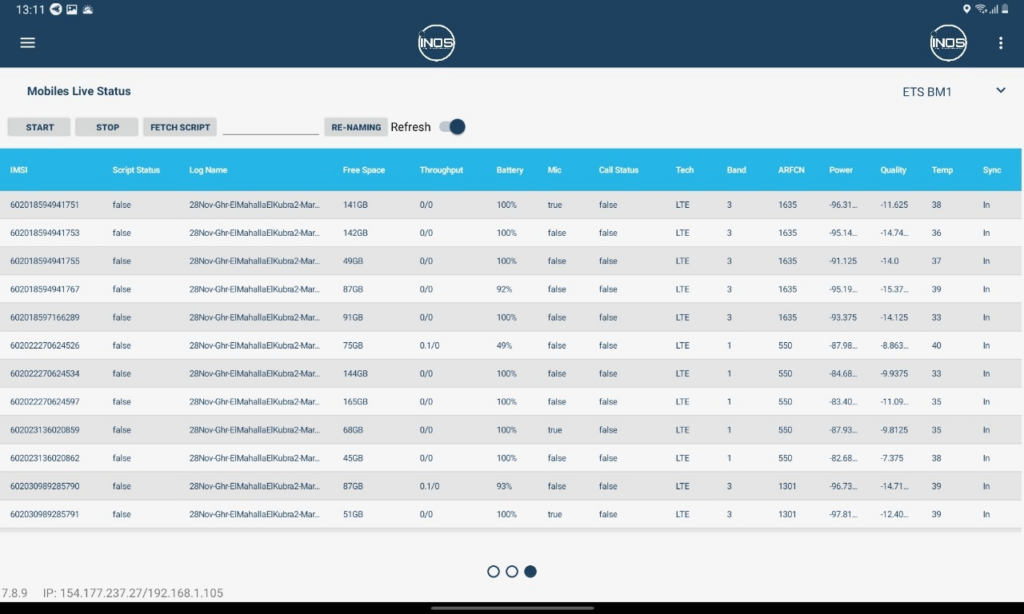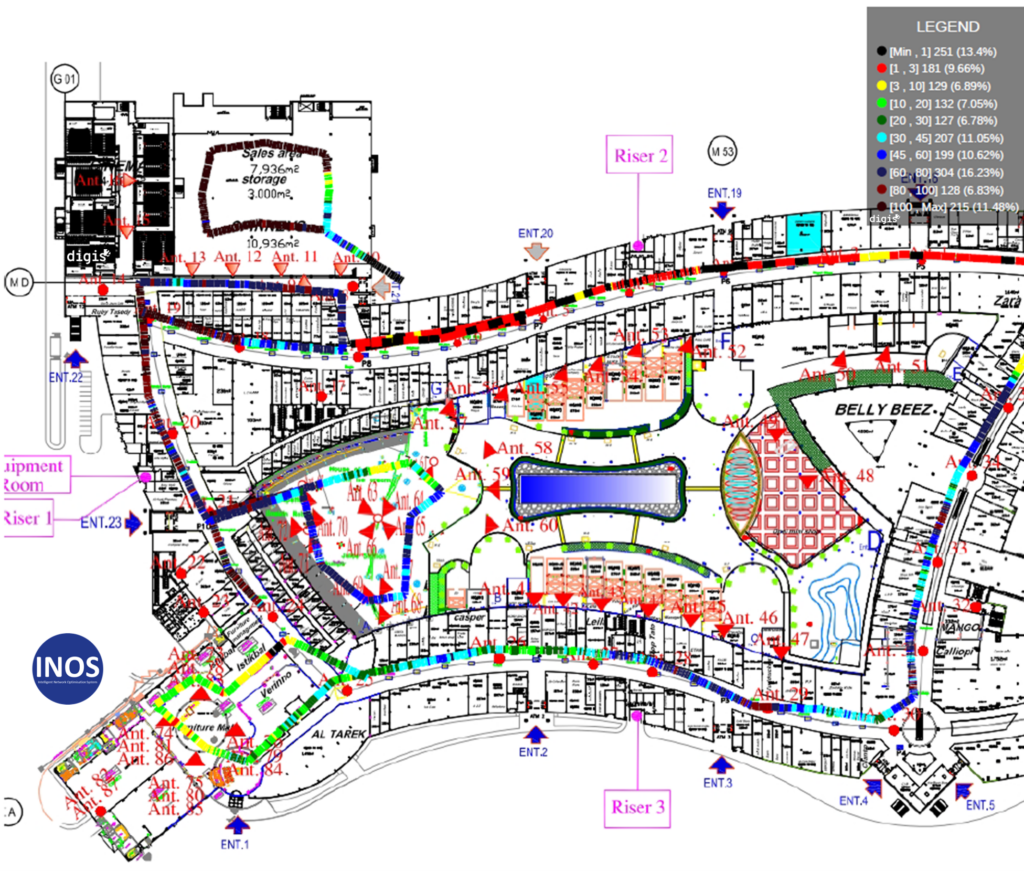In-building coverage testing without an engineer on-site, with INOS
Optimising the testing process with the INOS backpack, and remote engineering staff.
With an ever-growing volume of wireless network traffic produced inside buildings, network design and performance must be evaluated from within buildings. In this blog post, we assess the growing need for indoor coverage and the impact of the pandemic, plus Digis Squared RAN and Software Solution Architect and Trainer, Amr Ashraf, describes how in-building coverage testing without an engineer on-site can be undertaken, with INOS.
The ever-growing importance of in-building coverage
Often quoted research (1) estimated that “approximately 80 percent of wireless data traffic originates or terminates within a building”. Anecdotally, that figure is far higher now. Lockdowns and work-at-home mandates of the Covid-19 pandemic, plus the growing need to digitally maintain contact with friends and family are sure to have driven this even higher.
The pandemic has generated, and increased, specific needs for wireless connectivity indoors,
• Switch to working at home
• Increase in voice traffic and video conferencing/communication, gaming and streaming traffic as we stay connected online at home to friends and family
• Apps handling proximity detection/tracking and alerts about infected contacts
• Tele-medicine: urgent care assessments and consultations, updating families unable to visit, remote assessments and advice, maintaining safe care-homes for the elderly and hospice patients
Even aside from the pandemic, the explosion in social media and mobile-centric content generation and consumption has dramatically increased the volume of mobile data consumed indoors.
But if indoor coverage is poor, then this impacts both operator revenue, and, perhaps more critically, brand loyalty and churn, as the need to connect now, indoors is far higher than any remaining loyalty consumers (and businesses) have for an operator’s brand.
Testing wireless connectivity inside buildings
Digis Squared RAN and Software Solution Architect and Trainer Amr Ashraf shares insights into the challenges and solutions for testing indoor coverage.
“Indoor network testing presents its own set of challenges, not encountered when undertaking traditional outdoor drive-testing. These indoor challenges include everything from gaining physical access to the site, to collecting as much relevant benchmarking data as possible in a single pass, and determining whether solutions provide data uploads to the cloud and data processing in a timeframe that enables a technician to test and troubleshoot network issues in one visit – if there is poor network coverage indoors, this may impact the speed at which we can assess the results!”
“Indoor testing today utilises smartphone and tablet applications, with all equipment packed discretely into a backpack-based test solution for indoor network testing. This approach has led to the number of walk-testing options for interior settings significantly expanding in recent years. Then, with detailed plans or architecture drawings of the building, and an efficient walking route planned out, a team member can be tasked with wearing the back-pack, starting the app, and walking through the route.”
“As mobile network operators and communications service providers have concentrated more and more on in-building coverage, they often encounter a problem: they are unable to gather all the measurements they need in a single test walk.”
“Critically, it’s no longer necessary for the person walking the route inside the building to be an engineer. The technical assessment can be undertaken by skilled staff, remotely, ensuring your scarce engineering resource can be deployed efficiently across many projects. When an issue is detected during the building walk-through, the network can be optimised remotely – and because the INOS testing and analysis takes just 15 minutes from receipt of data, our aim is to ensure that we can re-test and re-walk the improved area as part of a single visit to the building.”

“One of our clients described testing a distributed antenna system at a major convention centre that served four wireless operators using three different wireless technologies across multiple channels, for a total of about 20 different operator/technology/band combinations, each of which required a separate measurement. A complex configuration, but one which is quite common in large business-focused buildings.”
“The indoor network testing for this project was carried out with INOS using the Digis Squared proprietary backpack-based In-Building Test Suite. In contrast to user-equipment-based backpack testing systems, which are typically restricted by the number of devices and technologies that can be tested concurrently, the INOS solution depends on a scanning receiver intended for multi-technology networks. That is to say, we are not constrained, there is no technical limit on the number of devices we can use in the testing.”
Undertaking an in-building survey
“The INOS backpack is a multi-technology integrated solution for testing and measuring multi-device mobile networks. Whether it’s for conducting an indoor or outdoor walk or cycle test, or an outdoor drive test, the INOS backpack offers a small design for portability and simple movement. Data interaction is accomplished by using a WiFi hotspot to link an Android tablet (as a controller unit) to test terminals. A powerful solution for portable multi-network benchmarking, supporting up to 20 test terminals and a scanner for testing and measuring simultaneously.”

“The measurements are transferred to the cloud for additional data management and processing, and the testing is undertaken according to the test plans given by the controller unit.”
“We use an Android tablet to operate all of the testing equipment in the backpack, connected via Wi-Fi to the test phones, which are also integrated into the backpack. This configuration gives the technician complete control over the devices, enabling them to add pinpoints throughout the in-building walk as data is collected, or repeat sections immediately after dynamic network optimisations are implemented.”

Case study
“Recently, a global Tier One mobile operator used the Digis Squared INOS backpack testing technology to investigate networks in Cairo. They wanted to undertake benchmarking on their own network, as well as those of their main rivals, both inside buildings and outside. Data speeds, latency, and web browsing durations were among the main performance parameters they tested with INOS, as were dropped calls and RSSI signal levels. Once captured, the INOS data collected was sent over the air to the INOS cloud-based platform for immediate automated analysis and presentation via an analytics dashboard.”

INOS advantage compared with traditional approaches
“One of the primary advantages INOS delivers is our very quick analysis and reporting capability. After just a few minutes of testing, we can practically immediately provide a comprehensive report with all KPIs.”
“The vast majority of network coverage-related complaints occur indoors, traditionally necessitating an engineer to visit the customer’s house or office to undertake a network evaluation – this legacy approach results in high operational costs, and scheduling delays in identifying the issue.”
“Let’s compare that with the INOS solution. Anyone can be tasked with capturing data with INOS, no technical knowledge is needed to carry the backpack around the building or location of interest. It is not necessary to divert a skilled engineer out in to the field to capture data – on some projects we’ve tasked Uber drivers with taking an INOS bag around a pre-defined route, and returning it to us, or asked a member of the admin team to cycle a route with the INOS backpack. The INOS system can even be utilised to submit a self-service complaint to skilled RF optimization specialists in the office, who can then undertake an initial assessment remotely using the INOS kit controller and web application. And of course, as only one person is needed to take the bag in a car, or walk it around a building, the solution is also Covid-19 safe.”
“INOS also enables operators and suppliers to capture data in the field remotely, analyse the data, determine which issues can be solved remotely, and then efficiently schedule and resolve problems which can only be addressed in the field .”
“If you want to know more, we’re always happy to chat through what we can do to help you. Meet us at MWC22 or let’s fix up a call online.”
In conversation with Amr Ashraf, Digis Squared RAN and Software Solution Architect.
If you or your team would like to discover more about our capabilities, please get in touch: use this link or email sales@DigisSquared.com .
Key Advantages of INOS
- Tablet: From the Android picture gallery, users can quickly import tiny to huge floor plans (of any form of structure).
- Floor plans and data are kept in the cloud and may be shared with co-workers.
- Ease of use, testing, and interior navigation can all be undertaken by non-technical personnel.
- In real time, test data is uploaded to the INOS Cloud server.
- Post-analysis: results can be mapped onto indoor floor layout, with a web-based dashboard.
- All-in-one mobile solution with device, network, and service benchmarking capabilities.
- From the standpoint of subscribers, it provides extensive network performance statistics.
- INOS is used as the test device, allowing for a single investment to be used for multiple purposes.
- Test procedures, data processing and analysis can be fully automated, resulting in increased overall efficiency, and optimised consistency.
Discover more
- INOS & LTE 600MHz: Network benchmarking & optimisation with INOS
- INOS & 5G: now with 5G & multi-vendor chipset support
- INOS & Africell: Africell selects Digis Squared to support new network in Angola
- Test and optimise LTE 450MHz, without handsets
- INOS & Regulators | Now more than ever, use independent tools and expertise
- INOS solution details
- INOS uses Intel® Xeon® Scalable Processors | Digis Squared awarded Intel Winner’s Circle Membership
Digis Squared, independent telecoms expertise.
Image credits
- Digis Squared social media and blog banner image: Sung Jin Cho
- With thanks to Digis Squared’s Ziad Mohamed
- All INOS images: (c) Digis Squared
References

